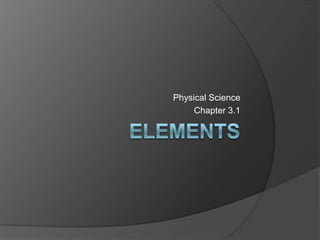Report
Share

Recommended
Recommended
More Related Content
What's hot
What's hot (20)
Similar to Physical Science 3.1 : Elements
Similar to Physical Science 3.1 : Elements (20)
Interactive textbook ch. 4 elements, compounds & mixtures

Interactive textbook ch. 4 elements, compounds & mixtures
Interactive textbook ch. 4 elements, compounds & mixtures

Interactive textbook ch. 4 elements, compounds & mixtures
MATTER ,BIOLOGY AND OTHER TOPICS FOR GRADE 6,7 ICSE SCIENCE

MATTER ,BIOLOGY AND OTHER TOPICS FOR GRADE 6,7 ICSE SCIENCE
More from Chris Foltz
More from Chris Foltz (20)
Physical Science 3.1 : Elements
- 1. Elements Physical Science Chapter 3.1
- 2. Objectives Describe pure substances. Describethe characteristics of elements, and give examples. Explainhow elements can be identified. Classify elements according to their properties. Bellringer What do gold, iron, and aluminum have in common? What do oxygen, neon, and sulfur have in common? How is silicon different from aluminum or oxygen?
- 3. Elements Elements pure substances that cannot be separated into simpler substances by physical or chemical means Are a Pure substance A substance in which there is only one type of particle Are made of particles called atoms.
- 4. Properties of Elements Each element can be identified by its unique set of properties. may share a property with another element, but other properties can help you tell the elements apart. Helium Unreactive gas Less dense than air Krypton Unreactive gas More dense than air
- 5. Identifying Elements by Their Properties Elements can be identified by using their physicaland chemicalproperties Nickel M.P : 1455 OC Density : 8.9 g/cm3 Conducts heat & Electricity Unreactive with oxygen in air Cobalt M.P : 1495 OC Density : 8.9 g/cm3 Conducts heat & Electricity Unreactive with oxygen in air Iron M.P : 1535 OC Density : 7.9 g/cm3 Conducts heat & Electricity Reacts slowly with oxygen in air
- 6. Classifying Elements by Their Properties Three major categories: Metals shiny, malleable, ductile, and they conduct heat energy and electric current Nonmetals dull, brittle, and conduct heat and electricity poorly Metalloids have properties of both metals and nonmetals Gold Sulfur Silicon